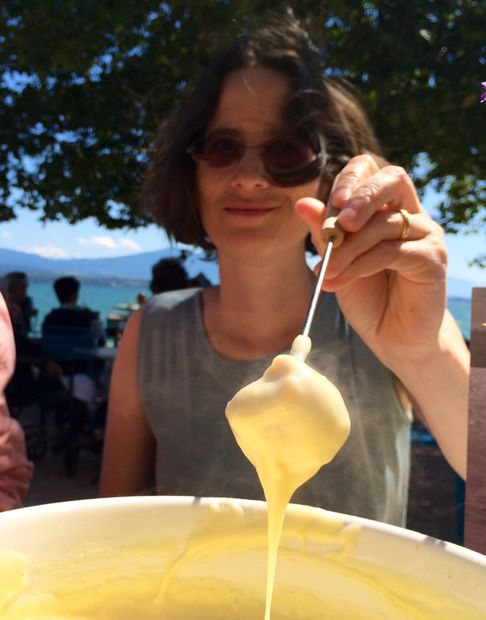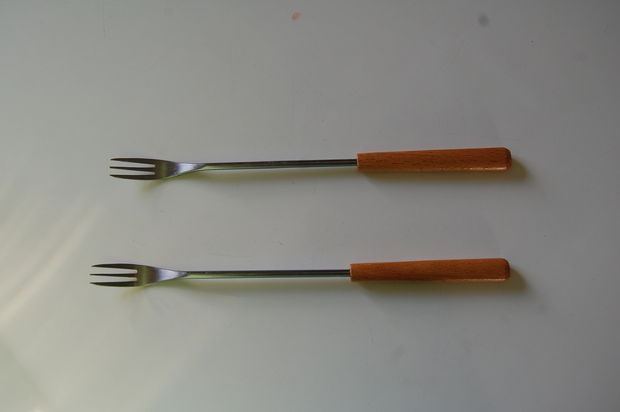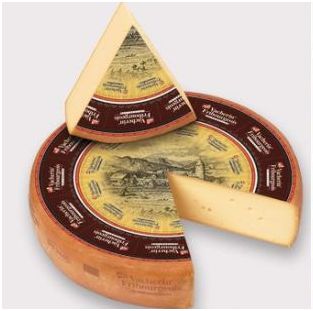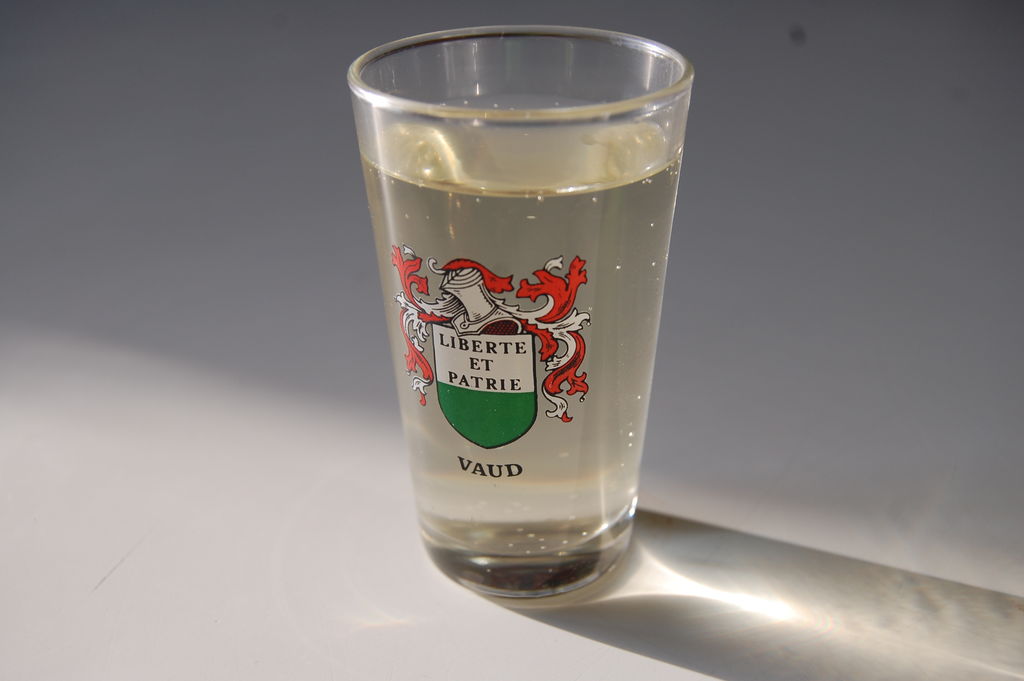Question ID: 4000-4915-0-1-2-3
Recipe Description
Fondue is a winter dish. If you have a hankering for some melted cheese in the summer, eat raclette instead (raclette cheese melted and scraped onto baby potatoes and cornichons). Fondue is also a social dish, and it should be shared with as many friends and family as can sit around the table and reach into the pot. Of course, rules are made for being broken... I usually jump at the chance to eat it whenever the occasion arises, even in the summer time.
The fondue pot is called a "caquelon" (kah klon -- but don't pronounce the "n"). It can be made of clay but most fondue restaurants prefer enameled cast iron pots. Not only are they stronger but they distribute the heat more evenly. The only drawback is that it might take the cheese a little longer to melt. Do not make fondue in any reactive pot, such as aluminum or any other metal, and never make it in any pot treated with a non-stick surface, such as teflon. The cheese needs to be heated constantly even as you are eating it. For this you will need a "rechaud" ("spirit stove" is the translation suggested by rabid_engineer -- it's a metal stand which holds the pot over an adjustable flame). If you don't have one it can be improvised: a few bricks, a sterno or even 6-8 tea candles and a metal grill from the stove-top or small barbecue will do the trick. Fondue forks are longer than standard forks, which makes it easier to reach into the pot, and narrower, to fit small pieces of bread. They are also sometimes color coded, which is not important for cheese fondue. It matters only for Bourginonne fondue, which requires you to let pieces of meat cook in hot broth or oil. You can use regular forks -- it just won't be quite as comfortable to share the pot with a group of people.
Cheese As I mentioned in the intro, there are many types of cheese fondue. This one, the moitié moitié, uses 50% gruyere cheese, and 50% vacherin fribourgois. If you can't find vacherin you can make a pure gruyere fondue. It won't be quite as creamy but it will still be delicious. The approximate amount of cheese is 200g per person, or about 7 oz. So for 6 people you'd need 1lb 5 oz of vacherin and 1lb 5 oz of gruyere. If this is your first taste of fondue, maybe you would use a little less. In New York City a store called Ideal Cheese in the upper east side sells both types of cheese, and I've also found them at Sahadi's on Atlantic Avenue and at Fairway. To locate a supplier you can contact a Swiss consulate near you. They are used to calls from homesick Swiss expatriates looking for cheese. Wine Swiss white wine is also hard to find, because it is expensive to produce (land and labor are at a premium in Switzerland), and because it is not appreciated as much out of the country as it is within. It you can get a Chasselat from Vaud (Epesses is my favorite), or a Fendant from the Valais. Otherwise search for a Chasselat from the Haute Savoie region in France. That's right across the lake, and their wine is similar and more widely distributed. You want something light and dry. Definitely NOT a Chardonnay or a sweet desert wine, but an Italian white such as Orvieto could work in a pinch. Potato starch is what most people use in Switzerland, but corn starch is more common in the US, and it works just as well. Kirsch is cherry brandy. It is possible to omit this ingredient and just use wine, but it adds a nice flavor. Garlic is not optional. It adds a necessary tang. You can even drop in a few larger chunks if you are feeling adventurous. Bread. The perfect bread is called "mi-blanc," but I've never seen it outside of Switzerland. It is a crusty white loaf of medium density. Whole grain bread is much too heavy, and baguettes are usually too light, although they will make an OK substitute. Portuguese peasant bread has the right texture. NEVER use pre-sliced sandwich bread. It won't taste right and it will fall apart in the cheese. In the French speaking part of Switzerland mi-blanc bread is cut into thick slices and served in a basket on the table, preferably on a red and white checkered napkin. People then break the slices apart with their hands. Swiss Germans will serve the bread pre-diced into bite sized pieces. No matter how many years they spend in the French speaking region, no matter how hard they work at hiding their accents, cutting up the fondue bread is a dead give-away. Season the fondue with freshly ground pepper, and a little nutmeg, if you'd like.
Before you start you need to be ready to serve, because you can't leave the stove while the cheese is melting, and you need to serve immediately as soon as it is ready. Set the table with salad plates (bigger than saucers, smaller than regular dinner plates). Cut the bread in thick slices or bite-sized chunks if you'd like to appear Swiss German. Set up the "réchaud" with a match ready to light the sterno. Get the caquelon ready by cutting a clove of garlic in half and rubbing the sliced side all over the bottom and sides of the pot. You want the surface to be coated with garlic juice and oil both for flavor and to prevent sticking. Prepare the gruyere by grating it. Prepare the vacherin by slicing it into chunks, approximately 1/4" wide. Keep the two cheeses separate. Measure out the wine. Swiss recipes call for one "white wine glass" for each serving. These glasses resemble shot glasses and contain a little under 1 dl, which translates as about 1/3 cup for 7 oz of cheese. Press one clove of garlic into each cup of wine. If you'd like to, cut up one clove into small chunks. Mix 1/2 tsp starch (corn or potato) per serving with the Kirsch. The amount of Kirsch can vary according to your preference, but you can start with 2 tbsp per serving. Once all the dinner guests are present you can start cooking. It will take about 10 minutes and everybody should be ready to eat the instant the cheese has melted. Put the wine and garlic into the caquelon and turn the heat to medium-low. Add the gruyere and stir continually with a wooden spoon. The cheese should melt but not boil. When the gruyere has melted, add the Kirsch with the starch mixed in and the the vacherin piece by piece. Let each piece melt before adding the next, and keep stirring continuously. Season with freshly ground pepper (and nutmeg if desired) to taste. Serve immediately.
Adjust the temperature of the sterno so that the cheese bubbles very slowly when the cheese is not being stirred. With the proper equipment this is easy, but if you're making do with an improvised system you will need to raise or lower the pot, or add or blow out some candles. Put a piece of bread on your fork, stir it around in the pot for a few seconds, then eat while the next person stirs in their bread. Grind some fresh pepper onto your plate and dip the cheese covered bread onto it before eating. Fondue is a rather delicate emulsion so it needs to be continually stirred. If everybody is chatting away and not eating, the cheese might separate into an unappetizing mix of rubbery cheese and oily juice, particularly if it is 100% gruyere or if the cheese is not fresh. If this happens not all is lost: take it back to the kitchen, mix some extra starch into a small amount of Kirsch and stir, stir stir over moderate heat till you get it back together again. If that's not enough, a small amount of baking soda might help. Whatever you do, NEVER drink coke with fondue, and I strongly advise against beer or any other cold carbonated beverage. Drink HOT tea (not iced) or white wine. Coke in particular does bad things with the cheese in your stomach. It makes the cheese rock hard and entirely indigestible. You will feel sicker than you have ever felt before. I am speaking from experience. In "Asterix in Switzerland" the hapless guest who accidentally drops his bread in the cheese gets thrown into the lake. The real tradition is a bit more mundane. Female guests are supposed to kiss all males gathered around the table and vis versa. As teenagers, bored by these rounds of kissing (we're talking three pecks on the cheek, not French kissing...) we used to play truth or dare. When you serve the white wine, offer the last drops in the bottle to whomever needs the most luck in love. These coveted drops are called "les amours." Once the melted cheese is all gone if you're lucky you will be left with a crispy brown crust stuck to the bottom of the pot. This is called the "religieuse" (translation: the religious woman -- don't ask me why) and it is the best part of the fondue. Scrape it off with your forks and enjoy... To clean up, pour cold water in your caquelon and let it soak overnight. If it's not too cold, crack open a window. Morning after smells of a fondue party are not very pleasant.
Some Swiss households have a special room, usually in the basement, devoted to eating fondue (and drinking, if truth must be told) called the "carnozet." (pronounced car-nots-ey) I had some friends in apartment buildings who had outfitted their rented storage cages in the basement with table, benches, and wine racks. We spent many enjoyable hours crammed into these small dark spaces eating, drinking, and making as much noise as we pleased. I would do it here in Brooklyn but I think it would spook my neighbors, and I need the storage... After watching Reagan's and Gorbachev's motorcades zoom by on their way to peace talks and attending my parent's dinner party with Raisa's interpreter I threw my own "red" fondue party. I baked red bread, dyed the fondue and the white wine with red food coloring (drinking red wine would have been unthinkable), and stupidly, lit the room with red lights which destroyed the effect of the dyed food. Everything just looked gray but we had fun anyway. In the dead of night, all decked out in our communist paraphanelia we roamed the empty streets, waving a red flag and singing the Internationale at the top of our lungs. We did not get arrested but we did get a few frightened looks. A melancholic fondue memory is my high school sweetheart's Thanksgiving visit during my freshman year in college in Providence, RI. Since we had no special equipment we huddled around the electric stove top in the deserted dormitory in a (failed) attempt to recreate the good cheer of fondue. It just made me even more homesick. Years later, a fondue compatible enamel pot from Zabar's became a tacit engagement present: it was the first purchase I made in common with the man I later married. Despite his Tennessee roots he shared my enthusiasm for melted cheese, which was a definite selling point. I proposed to him in the subway on the way home from a Swiss restaurant in the East village. I didn't mean to propose in the subway -- I meant to do it over fondue, but somehow the cheese did not give me enough courage. I was only able to blurt out the question as the N train pulled away from City Hall. One last warning about fondue: it always gives me weird dreams. Not bad, just vivid and unsettling. Euro art film dreams.
Question & Answer
Question: What is the correct order of the images?
Choices:
    |
| (A) |
    |
| (B) |
    |
| (C) |
    |
| (D) |
    |
|---|
 (A) (A) |